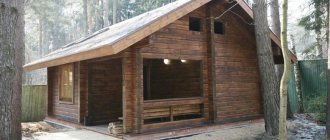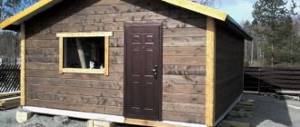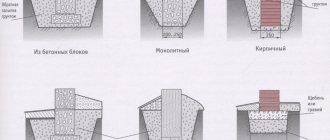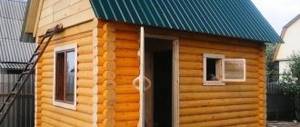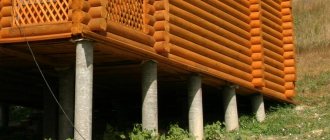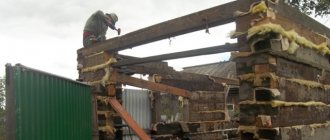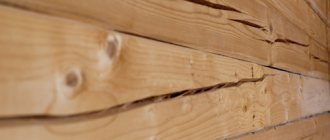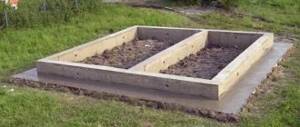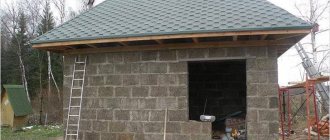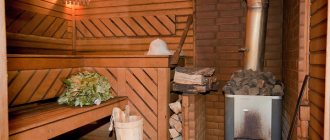Leisure at the dacha is rarely complete without a visit to the bathhouse. This is a great way to relax after a hard day and spend time with family and friends.
You can build a bathhouse yourself, but you will have to work through each stage of the work, be patient and have time. To save space, structures combined with a house, garage or gazebo are used.
We will examine the main aspects of self-building a bathhouse in more detail in this article.
Types of bath structures
We will analyze various types of bathhouse design, both as a separate building and in combination with others.
Freestanding
The construction of a full-fledged bathhouse in the country is a costly construction.
Such a bathhouse is a separately equipped building with three main rooms:
- steam room;
- washing (shower);
- dressing room (dressing room).
If the area allows, then a recreation area, living room, bedroom, and dining room are additionally equipped. There are projects of two-story baths and with an attic.
A bathhouse made from fresh logs or timber looks great. Cheaper than wooden structures made of foam concrete and cinder block.
For a small building, a lightweight columnar or pile foundation is sufficient. Recommended roof type - gable .
For year-round use, you will have to think about heating. To do this, you can install a compact stove using wood, gas, or electricity (your choice).
The disadvantages of a separate bathhouse are the high consumption of building materials and the fact that it takes up a lot of space on the site.
The advantages are that this is a separate room for relaxation and bathing procedures do not interfere with other residents.
On the first floor of the house
The construction of a bathhouse under the same roof as a residential building can significantly save free space in the yard.
The rooms inside the house are effectively used. The living room will also serve as a relaxation room. The bathroom serves as a washroom.
Inside the house, a room is simply allocated for a steam room. Other rooms are already included in the building layout.
A decision about arranging a steam room in a private home needs to be made at the drawing development stage.
The advantages of this layout:
- Saving space inside the yard. This is especially true for areas with small areas.
- You don't need to go outside to move between rooms.
- There is no need to make a separate heating system.
- Minimum construction costs.
Minuses:
- High fire hazard. Provided that all fire safety rules are followed, there is always a risk of an unexpected fire.
- A high-quality vapor barrier is required.
- Installing a complex ventilation system will be expensive.
Since there is high humidity in the steam room, this entails a special approach to waterproofing the room and choosing materials for finishing.
Extension to the house
Builders recommend attaching a bathhouse to a house when it is made of brick or foam block. It is unsafe to make an extension to a building from timber or boards. You can use the summer terrace area for the sauna or pour a separate foundation.
It is recommended to complete the construction of the bathhouse at least two years after the shrinkage of the residential building.
It will be convenient to lay the necessary communications into the room and connect the heating system.
Protection against high humidity is carefully thought out. If the floors are wooden, then the wood will need to be treated with fire retardants (protection from fire) and antiseptics (from rotting). When using a wood-burning stove, debris and fumes from the firebox may enter the house, so cleaning will have to be done more often.
Photo: extension to a house made of OSB. Can serve as both a veranda and a bathhouse.
Before laying the flooring, it is important to consider the location of the drain so that moisture is promptly removed from the room.
Combined type
Photo: bathhouse with gazebo
To expand the functions of the building, the bathhouse is often combined with other buildings:
- terrace;
- gazebo;
- summer kitchen;
- garage;
- utility unit;
- barbecue area.
A simplified version is a bathhouse with a porch and vestibule.
Photo: project of a brick house with a bathhouse and a garage
One of the most popular projects among summer residents is a combination with an open or closed terrace or veranda. The room is equipped with a barbecue, a stove, and a table with chairs is installed in the center of the room.
There are two-story complexes with a balcony or attic, with an indoor pool. For convenience, a garage is attached to one side.
In villages it is common practice to combine a bathhouse with a summer kitchen. The room is divided into a cooking and eating area. The structure is most often assembled from budget materials (boards, slabs, blocks) and used according to the season.
On wheels
A modern mobile type of steam room. Many owners have turned it into their own small business, providing on-site bathing services.
Inside there is a steam room, a mini-bathroom and a changing room; in economy class buildings there is only a steam room.
It is customary to build a structure from lightweight lumber for easy transportation.
Caravan
A simple mobile bathhouse. Building it yourself will be inexpensive.
It is allowed to install the trailer directly on top of the soil or shallow foundation.
In standard layouts, the area is small, so if you plan to vacation with a group of more than four people, it is better to choose other layouts.
Barrel
The non-standard shape and arrangement of the bathhouse is gaining popularity among owners of suburban areas. The barrel takes up little space and is suitable for constant use.
A potbelly stove is used for heating. When installing on the ground, arranging a foundation is not necessary. To strengthen the frame, metal rings are attached around the perimeter.
A round bathhouse decorated with wooden clapboard looks beautiful.
Temporary
A homemade temporary shed is cheap, requires a minimum of building materials, and is assembled quickly.
Used only in warm weather. The wooden frame is often simply sheathed with plastic film.
Another option is a tent. It is used temporarily for one-time use, and then collected. Suitable for country or outdoor recreation.
Installation of a sauna stove
2 wood-burning heaters : metal and brick . Let's talk about them in more detail and won't ignore electric ovens.
Metal furnaces
A metal batch oven without a container for heating water is very compact. In an iron casing with doors, grates with a stove are placed on metal shelves, which make up the bottom of the combustion chamber.
There are cavities inside the body where stones . Heaters come in open and closed types. When the stove is operating, gases enter the chimney pipe, passing through the channels. The firebox is usually lined with bricks:
The furnace is equipped with chimneys consisting of downwells and collection pipes. The rock chamber has two doors, but chimneys are often installed to allow flue gases into the bottom of the rock chamber from the space around the duct.
Brick heaters
The construction of a brick heater begins with the construction of its foundation. To prevent the stove from sagging or tilting due to soil freezing or moisture, the base must be deepened by 0.5 meters. The transverse dimensions of the support should be larger than that of the stove by one brick .
The foundation for the furnace does not need to be combined with the wall foundation . The distance between them is at least 5 centimeters.
The best foundation is rubble concrete or concrete. In dry soil it can be built from bricks using cement, lime or lime-cement mortar.
The surface of the foundation must be filled with cement-sand mortar, leveled with a lath and covered with waterproofing. Usually this is roofing felt or roofing felt, which is laid in 2 layers (point 4 in the diagram below):
The designations on the diagram are as follows:
- Sole.
- Underground part.
- Upper ledge.
- Waterproofing.
- Kiln masonry.
The building material for the construction of the furnace is ordinary solid brick. Under no circumstances should silicate or hollow bricks be used for masonry.
For more information about sauna stoves, see our article - choosing a sauna stove equipped with a water tank.
Electric heaters
In modern baths, air up to 100 °C is most often heated with an electric heater with a built-in automatic control device. The control unit turns off the heating element when the temperature of the casing exceeds the permissible norm, as well as when, for example, a towel gets on the stove.
An electric heater in a bathhouse must be equipped with a temperature limiter that turns off the heating element, and a time relay that stops the supply of current to the heating element after a certain operating time (up to 5 hours). Today the market is full of various modifications.
Nuances of frame construction of a bathhouse
Many owners do not want to spend a lot of time constructing the structure, but rather quickly assemble it and relax their souls and enjoy bath procedures. In this case, there is nothing to decide - the frame assembly technology is exactly what is needed.
You will have to start by assembling the frame. The walls are made like a lattice. Materials you will need:
- timber of different sections;
- thermal insulation material;
- material for external and internal cladding.
In the latter case, the following will do:
- siding;
- block house;
- OSB;
- edged board;
- lining.
For the frame, it is recommended to take boards from larch and aspen. They are more resistant to moisture and have low thermal conductivity.
Basic construction steps:
- The lower frame of the beam is assembled. Dimensions - 100*100 mm. Holes are drilled at the ends of the material. The elements are fastened together with self-tapping screws. When using timber of smaller dimensions – 50*100 mm, the elements are mounted end-to-end on metal corners.
- After this, a strapping board is installed at the end. Floor joists go right next to it (a 50*100 mm beam is suitable).
- On the other side, the logs need to be cut so that another end board stands up for strapping.
- The logs are placed so that it is convenient to attach the heat insulator between them.
- A timber measuring 50*100 mm is suitable for the wall frame.
- For vapor barrier it is better to use film, for thermal insulation - mineral wool.
Photo: frame bath project
Thermal insulation and wall finishing are carried out after the roof is attached.
If you don’t have time to build a bathhouse yourself, you can choose a project and order its installation. Small baths are delivered assembled.
Features of the finished product:
- Assembled on a wooden frame.
- The cladding is done with lining, profiled timber (optional).
- It consists of three rooms - a steam room, a shower room, and a dressing room.
- An electric heater is used for heating.
- The water tank is mounted on the roof. A drain pan is installed under the floor. The drains exit through the pipe.
Finishing work in a bathhouse made of rounded logs
You can begin interior decoration after caulking the walls and laying communications. It is necessary to start installing floors , which are most often installed on logs, although in a washing room it would be more convenient to use a concrete screed with the possibility of laying ceramic tiles or other material with similar characteristics.
The walls of the bathhouse do not require special finishing, since the wooden frame itself has a very aesthetic appearance. But to protect wood, you can use varnish or colorless impregnations, but this is true for all rooms except the washing room and especially the steam room.
In the washing compartment, you can protect the walls and ceiling with moisture-resistant decorative materials, but be sure to take care of the problem of vapor barrier and moisture removal. To do this, it is necessary to install special ventilation gaps between the rounded log and the finishing coating.
Things are different in the steam room - since coniferous wood is often used to build walls, which actively releases resins that can slightly spoil the appearance of the walls. Therefore, it is better to sheathe the steam room with clapboard made of hardwood , for example, linden, alder, oak, etc.
In the event that the diameter of the rounded log for the construction of the bathhouse was selected correctly, then there is no point in dealing with the external decoration of the walls - such a structure has its own charm, and bathhouses look especially impressive if the ligation of the crowns is done “without remainder”, although in this case , more expenses will be required for the purchase of material, but the corners will be warmer , since cold bridges will not form at the joints.
Which place to choose for a bath
The norms for the distance of buildings are clearly stated in SNiP 30-02-97. This document regulates the construction of various types of structures in the country, in the village, in the city.
Among the main requirements for the location of the bath are the following:
- The distance to the neighboring fence should be more than 1 m.
- To any neighboring wooden building - from 15 m.
- The distance to a residential building on its site is over 8 m.
- Distance from the street, road - from 5 m.
- The distance to any structures made of non-combustible materials is from 6 to 11 m, to wooden structures with non-combustible cladding - 8-12 m, completely wooden - 11-15 m.
- The distance to the forest is 15 m, the nearest body of water is 5 m.
- The distance from tall trees is 4 m, from bushes - 1 m.
- A distance of at least 12 m will have to be made from a well or well with drinking water.
The best place to locate a bathhouse is considered to be the backyard. The ideal option is when it is the southern part of the estate - the building will be protected from the wind. The windows are facing west.
In addition, good ventilation and drainage should be considered.
Roof and roofing
The rafter roof consists of the following elements:
- Rafter truss . A rigid bundle of beams that serves to distribute and absorb loads that arise in the system. Rafters are the main massive parts of the structure onto which the weight of the entire roof is distributed. Stiffening ribs enhance the stability of the beams.
- Lathing . A horizontal base made of timber, packed on top of the rafters to tightly fasten roofing materials.
- Mauerlat . A wooden beam placed on top of the finished walls and used to connect the rafters to the walls of the building.
Details about the Mauerlat can be found in our material - Mauerlat in construction: calculation features and application.
Below are the main, time-tested construction schemes :
Selection of materials for insulation and vapor barrier
When the bathhouse is combined with a residential building and is under the same roof, external thermal insulation is used to use the building all year round.
If the Russian bathhouse is a separate building, then internal insulation is enough.
In addition to insulation, it is important to provide high-quality vapor barrier protection for walls and other elements of the structure from moisture. The absence of a layer will lead to damage to the insulation and rotting of the wooden frame elements.
For vapor barrier use:
- Film. Thick film comes with or without a reinforcing coating. It costs little.
- Membrane. The non-woven fabric fits perfectly on top of the insulation and protects well from condensation.
- Foil coated sheets. Metal lavsan will help not only cope with moisture, but also retain heat indoors.
In frame structures, insulation is one of the stages of wall construction. The best material option is mineral wool.
Key requirements for thermal insulation in a bathhouse:
- hygroscopicity;
- environmental friendliness (the material should not release toxins when heated);
- low thermal conductivity;
- fire safety;
- ease of fastening;
- holding shape.
It is permissible to use the following insulation materials:
- Polymer. Suitable penoizol, polyurethane foam. Penoizol with a layer of foil is well suited for a steam room; it retains infrared heat radiation indoors.
Expanded polystyrene and its derivative polystyrene foam are prohibited for insulating steam rooms. They are flammable and release toxins when heated. They can be used to insulate the dressing room and rest room.
- Mineral. This category includes glass wool, mineral or basalt wool. They do not burn and do not emit toxins. This is the optimal solution for a bath. Minus - they can become saturated with moisture, so a vapor barrier will be required.
In frame buildings, organic heat insulators can be used - mixtures of gypsum, sawdust, expanded clay, and lime.
Interior decoration of the bath
Avoiding the use of coniferous trees to decorate the interior of the bathhouse, they use alder , aspen , linden , and , less commonly, larch and cedar .
Aspen is an almost ideal answer to the question of choosing a material for interior decoration.
The ceiling in a log, brick and panel bathhouse is done in the same way. A distinctive feature of the ceiling for chopped “soap” is that it can be made of boards. This will give the structure a natural look. The result is a “antique” interior, but there is also a practical meaning : natural roofing provides intense air circulation with good thermal protection.
Additional thermal insulation can be installed :
To install a ceiling for a bathhouse, you need wood that has low thermal conductivity and tolerates changes in humidity and temperature well. Low resin content.
A guide to the selection of building materials is available on the website - a complete thermal conductivity table.
The temperature under the ceiling of the bathhouse is the highest and if the boards contain a lot of resin, then it will drip down . Therefore, for arranging the ceiling and interior decoration of the steam room, you should use only hardwood .
Step-by-step instructions for building a bathhouse with your own hands
Let's look at the main points of self-construction.
Site preparation
Consists in determining the type of soil. The choice of foundation depends on this.
Debris and vegetation are removed from the future site, the top 15 cm layer of soil is removed. Pegs are driven in around the perimeter and a rope is pulled.
After this, you can start digging holes for pillars, foundation pits, trenches (depending on the type of foundation).
Pouring the foundation
For a frame bathhouse, small, made of blocks, a columnar foundation will be enough. If it is made of brick, stone, logs, a monolithic concrete strip with a low level of penetration is more reliable.
Walling
In a structure made of blocks, it is necessary to start by leveling the base. The easiest way to do this is with a cement-sand mixture. After drying, the roofing material folded in half is laid (it will perform the function of waterproofing).
Laying should be started from the corners. The first bricks are placed and compliance with the plane is immediately checked. If they match, a rope is pulled along the upper edge, which will serve as a level for the entire row.
It is important to take into account that bricks are placed on a mixture of cement and sand, foam concrete blocks are placed on special adhesive mixtures.
Jumpers are installed at the location where the future door and windows will be installed. The formwork is attached to the top. An armored belt is created in which the foundation bolts are fixed in order to then secure the Mauerlat. As soon as the solution gains strength, it is allowed to proceed to assembling the roof.
Floor installation
In frame structures, the principle of flooring is simpler - insulation is carried out, a finishing board is laid.
In other types of structures, the installation order is as follows:
- Lag fastening.
- Creating a subfloor.
- Vapor barrier flooring.
- Fixing the insulation.
- Laying a waterproofing layer.
- Laying the finished floor - laying prepared boards.
The bathhouse has a concrete and wooden floor.
Craftsmen recommend making an insulated solid wood floor in the dressing room. In the shower and steam room, it’s better not to skimp - make a concrete shower and simply lay grates of boards on top, which are taken outside for drying.
It is not recommended to try to lay a flood floor yourself without experience. It should be done on a slope so that all moisture and condensation collect in one place. At this point there should be a sewer opening for water drainage.
To make the concrete floor look more beautiful, ceramic tiles are used. The tile will be very slippery. Wooden gratings can be placed on top if desired.
Roof installation
The choice of roof type depends on the complexity of the structure and terrain features:
- Gable. Suitable for densely populated areas, dacha cooperatives, where there are no strong gusts of wind. Reduces the load on the walls.
- Single-pitch. It is chosen when the bathhouse is an extension to a residential building.
In the steppes, in regions with strong winds, the roof is made at a slight angle.
The general procedure for installing a gable roof is as follows:
- Installation of the Mauerlat. The roof truss system is fixed on it.
- Flooring layer of waterproofing.
- Fastening the sheathing strips in increments of 1 – 15 cm. The exact figure depends on the choice of roofing material.
- Laying roofing materials (slate, corrugated sheets, roofing felt, bitumen shingles).
Don't forget to thermally and waterproof the ceiling. Otherwise, condensation will begin to gradually destroy the roof beams.
Bricklaying or installing a metal stove
Installing a full-fledged brick oven involves pouring a separate foundation for it. The weight of the furnace sometimes reaches 1.5 tons.
The brick oven is characterized by high fire safety and significant dimensions. It is capable of heating large areas and retaining heat for a long time.
For masonry, a mixture of refractory clay is used that can withstand high temperatures.
The downside of a brick oven is that it takes a long time to warm up and consumes a lot of wood. We recommend reading: “What mortar to plaster a stove so that it doesn’t crack.”
For small baths, a metal stove like a potbelly stove is suitable. Sold with or without built-in water tank. If there is no tank, then a horizontal oven is used.
A metal stove is compact, heats up quickly, and consumes much less wood than a brick stove.
The downside is that it is a fire hazard.
A protective screen is made of bricks around it. The nearest 1.5 m from the stove are laid on the floor with sheets of metal or other non-combustible material.
According to the principle of action they are divided into:
- Closed. The vertical one has 3 main parts: at the bottom there is a firebox, in the middle there is a heater, and on top there is a water tank. It takes a long time to heat up, but it also retains heat many times longer.
- Open. The stones are laid outside the furnace, in the public domain. To increase steam, they are watered with water.
Interior finishing and insulation
When the walls are built, it is necessary to begin thermal insulation of the walls. To do this, wooden blocks are mounted to the walls in increments of 50 cm. If the walls are made of blocks, then the bars are attached to dowels. Their width is selected according to the dimensions of the insulation. It is best to use mineral wool.
Insulation is placed in the spaces between the bars. A vapor barrier film or membrane is laid on top of it. It is better to fix it with a construction stapler.
The lathing is again made on top, already under the finishing material. Slats 2 cm thick are suitable.
The best finishing material for a bathhouse is considered to be lining made of linden, alder or aspen.
It is contraindicated to use softwood lumber in the steam room, as they release resin when heated. It is unacceptable to cover it with OSB and fiberboard sheets - they are deformed under the influence of moisture and emit harmful substances when heated.
What else is important to know: “How to properly install wiring in a bathhouse.”
Installation of shelves
The shelves in the steam room are made of deciduous trees. The size calculation is carried out strictly according to the size of the room. A frame is assembled from timber, onto which a polished edged board and lath are mounted.
Exterior decoration
For exterior decoration the following are used:
- siding;
- block house;
- painting;
- decorative plaster;
- lining;
- facade tiles;
- facing brick;
- Wall panels.
The structure made of foam block and brick is finished with decorative plaster and clinker.
For plastering, make a mixture of cement and sand in a ratio of 1:4. The walls are covered with mesh. Apply one layer of mortar, then a second, rub it, give relief or level it. Give it time to dry. Paint it in the color you like. The siding will also look beautiful. Frame structures are covered with clapboard.
What are they collecting for?
Logs or beams are not just stacked on top of one another, they are fastened together. It is impossible without fasteners. During the drying process, both the logs and beams “twist”. The installed fasteners hold them in place, preventing them from turning too much. If there is no fastener, the crowns fall out or in, depending on the direction of the prevailing forces. Most often this is observed on gables, in walls where there are windows and doors.
Loose crowns fall out
Fasteners can be metal or wood. It’s easier, of course, with metal ones - you don’t need to prepare them and it’s more familiar to work with them. But the metal does not change in size, and the wood dries out. As a result, the log house does not shrink during drying, but “hangs” on the studs. This leads to the formation of large gaps between the crowns. So metal pins are only permissible when assembling a log house from laminated veneer lumber: it does not dry out. Nails should not be used at all. They are not for the log house.
It is also not recommended to use pieces of reinforcement, spring units and, in general, any metal. Wood conducts steam, and it will condense on the metal with all the ensuing consequences (rapid oxidation and destruction of the metal, and wood “hangs” very well on rusty metal, another disease is the proliferation of fungi in a humid environment). So if you decide to assemble a wooden frame, it is assembled using wooden fasteners.
Nageli
Dowels and dowels are made from wood. Pins are long thin bars of round, triangular or square cross-section. More often they use round ones; holes of a slightly smaller diameter are drilled for them (1-2 mm less than the diameter of the dowel), into which the bars are hammered. For triangular or square ones, you need to select a larger drill diameter, and drilling with them will be very difficult.
Nageli
The length of the dowel is calculated depending on the cross-section of the beam: the height of the three crowns is multiplied by 0.8. If you have a beam 200*200 mm, then three rows is 600 mm, after multiplication we get 600 mm * 0.8 = 480 mm. The dowels should be of this length.
The most popular diameter/section of dowels is 25 mm or 30 mm. They are made from hard wood - birch or oak. Spruce resists torsional forces very well, so spruce can also be used. If you follow the SNiP standards, then the dowels must have a moisture content of no higher than 12%, they must not have knots or other defects, and they must be treated with antiseptics/fire retardants before use.
Drilling must be strictly vertical
Place the dowel at a distance of 200-600 mm from the edge of the log/beam, and then every 1.5-2 meters in a checkerboard pattern. They are placed strictly vertically, in the middle of the log/timber. To prevent the crowns from hanging on the fasteners when the wood dries, the holes for them are drilled 2-3 cm deeper. To make it easier to track the depth of the hole, wrap a strip of masking tape or bright electrical tape around the drill. They are used to navigate. Then, even with a significant reduction in size, the log house will sit evenly.
Assembling a log house on a dowel - installation diagram
When driving in dowels, it is important to control the effort and hit strictly from above so as not to crack the wood. To make it easier for them to “fit” into the holes, they are dipped in oil (you can use it for mining).
When assembling a log house from timber or logs, the work technology is as follows:
- The first two or three rows are fastened with dowels, spacing them at the required distance.
- Next, two more crowns are laid and fastened to the top row of the previous package. Only now you move the dowels so that they don’t end up on top of each other, but move in a checkerboard pattern.
- Next, two crowns are placed again and connected to the top beam of the previous package (also shifted).
Now a little about the prices of dowels. They are usually sold individually. The price depends on the size and type of wood, but we can definitely say that they are expensive. To save money, people buy rake handles (they have the right diameter), cut them into pieces of the required length and use them. Just note that knots and other wood defects must be cut out.
Square dowel
It’s even cheaper to buy a board of suitable wood (dry, “elite” grade, without knots or defects) and cut it into bars of the required size. For example, you can buy a 50*25 mm board, make 25*25 mm bars from it, cut it into pieces of the required length, and slightly sharpen the edges. Apart from the time investment, this approach is the least expensive.
Dowels
Assembling a log house using dowels is less popular because it takes more time. They only hold two crowns together, so there's more work involved.
Assembling the log house with dowels
You need to cut holes for each dowel in the top and bottom logs. Install the prepared fastening bars, then carefully “put on” the upper crown. The work is precise, long and hard.
What does a dowel look like when cut?
Log processing method
So, if you want to build a sauna with your own hands from a log and prepare the material yourself, you will need a list of tools, as well as woodworking skills.
Required tools:
- saw;
- scraper for cleaning wood from bark;
- axes: the first - weighing 1.4 kg with a handle of 60 cm and sharpening at 25⁰, and the second - weighing 0.9 kg with a handle of 50 cm and sharpening at 20⁰;
- plane;
- an ax with a round blade for grooves;
- clamps for logs - these can be either metal brackets or two boards with grooves made in them;
- coated thread;
- trait.
All logs must be subjected to further processing no later than two weeks after harvesting and drying (more details: “How and with what to treat a log bathhouse - rules and methods of processing”). Otherwise, working with them will be much more difficult.
Here are detailed instructions on how to assemble a log sauna with your own hands.
At the first stage, you should adjust all the logs to the required dimensions, after placing them on the clamps. The “bowl” connection assumes the presence of an additional 30-60 cm of length in each element. But when fixing “in the paw”, the logs are cut exactly according to the design dimensions. If the thickness of the logs on different sides differs by more than 3 cm, then the size must be set aside from the center, adjusting the diameter from each edge separately.
The next step is to remove knots and bark. First, the work is done with an ax, and finishing is completed with a scraper, stripping the wood to a yellow color. The remaining loose top layer is trimmed off with a plane. Since after this procedure the tree is deprived of its natural protection, it must be treated with an antiseptic.
After this, you can begin processing the rim logs. These will be the thickest structural elements. The log is laid so that the winter side, that is, the area with the densest concentration of annual rings, faces outward. Next, a diameter line is drawn at the end, and markings are made parallel to it for cutting. Similar manipulations are performed on both sides of the log.
Now you can make small notches and, placing coated thread in them, draw a cut-off line along the entire length of the beam. After this, every 30 cm, notches are cut out with an ax, leaving about 1 cm to the desired depth, and then a layer of wood is gradually removed with a smaller hatchet, moving from one notch to another. Final cleaning is done with a plane.
Next, you need to make a dressing mechanism, as well as a longitudinal groove in the shape of a crescent. It is advisable that the moon groove be located at the bottom of the log, then water will not accumulate in the recess.
So, after trying on the log, you should calculate the width of the future groove, which is 2/3 of the average diameter of the adjacent elements. For example, the diameter of the ends is 250 and 235 mm, then the average value will be (250+235)÷2 = 242.5 mm. In this case, the width of the groove will be 242.5 × 2/3 = 162 mm. The depth of the channel will be equal to half the average radius. Of course, the obtained values can be slightly rounded.
In this case, the dimensions are taken from the lower beam, and marks are applied to what is laid on top. For ease of use, you can use a dash. Please note that for areas with different climatic conditions there are standards for the width of the lunar groove. So, for the lower value of -40 ⁰С – it is at least 16 cm, for -30 ⁰С – at least 12 cm, and for -20 ⁰С – no more than 10 cm.
Markings for removing wood along the entire length are made in the same way as with the frame crown. It will be more convenient if you cut a furrow in the center and then remove the wood using an ax or saw. You can use an adze. The surface is adjusted using a plane.
To understand how well the logs fit, any dye or coal chips are applied to the surface and tried on. By assessing the intensity of coloring, you can draw conclusions about the quality of processing and correct flaws.
Now you need to do the corner connection. To lay “in a bowl,” markings for the bowl are applied using a line extended by ½ of the average diameter of the log being placed in the recess. Having cut several vertical notches, the work is completed to perfection with an axe, plane or chainsaw. The result will be a semicircular gutter.
In the absence of a line, you can use two pieces of wire 6-8 mm thick, attached to the handle of a hammer.
But when building a bathhouse from a log with your own hands using the “paw-on” fastening technique, you will have to work hard. The first to be harvested are logs, that is, logs with grooves. In this case, the logs are always placed in the same plane, that is, on both sides of the same log.
To determine the width of the logs, take the thinnest log and calculate the value of 2/3 or 3/4 of its diameter. The depth of the logs will be equal to the average diameter of the thickest log. Moreover, these values will be unchanged for the entire material. You need to set the width of the blockheads starting from the center line.
Then you can start cutting out the paw. To do this, two log frames are made in the upper and lower parts of the block, the depth of which is equal to the width of the groove. After this, the joints are made, dividing it into 8 equal parts. To ensure that all elements are the same, you can use a trait or a pattern.
However, if the process of processing compounds is too complicated for you, you can purchase the material with ready-made compounds.
Note that when processing wood, it is better to use an ax, which clogs the fibers in the working areas, and the tree is less susceptible to fungus and parasites.
Stage III. Laying the foundation
Diagram of a strip foundation for a bathhouse.
The foundation for a bathhouse made of rounded logs must be laid to the depth of soil freezing. The most optimal is a strip foundation, which, due to its massiveness, can withstand heavy loads, and logs, as you know, are far from the easiest material for construction.
A columnar foundation is suitable for building a bathhouse only if the bathhouse consists of a special frame made of wooden beams and special panels that will be attached to this frame. Of course, such a bathhouse design is much lighter than when the logs are tightly packed on top of each other, and the foundation is no longer needed as powerful as a strip one. But on the other hand, such log frames have not yet proven themselves to be reliable. You can read about certain types of foundations in the “Foundation” section on our website.
Useful tips
In order for the bathhouse to be in working order for a long time, you need to know the subtleties when building a structure:
- Logs for the log house are harvested in winter. This is necessary because during winter harvesting the log undergoes less rotting and is resistant to various precipitation. To check whether the logs were harvested in winter, iodine is dripped onto them. A bluish spot should form.
- To ensure that the building lasts as long as possible, all wooden structural elements are treated with an antiseptic.
- To increase the thermal capacity of the structure and give it a beautiful appearance, it is necessary to fill all joints and gaps with tow. It should not protrude further than the logs, otherwise it will get wet and rot.
- If you choose the “foot-to-foot” method of fastening logs, it is necessary to protect the corner joints. To do this, they are sheathed with boards.
- It should be remembered that during shrinkage, the height of the building will decrease by 5 or 10 percent.
- Cutting the material to the center will help prevent cracks from appearing in the log.
- Caulk work is carried out in dry weather.
- They increase the stability of the structure and prevent the displacement of logs by securing them with dowels, installed in holes in the center of the logs.
Thus, making a log house with your own hands, although a complex process, is doable. In the video presented for this article you can find complete information on this topic.
Stage IV. Preparation of logs
Types of logs for a bath
After the trench has been filled and a vapor barrier has been made for the foundation, it is necessary to begin preliminary preparation of the logs for construction. All ends of the logs must be cut to a thickness that is equal to the upper diameter.
But to build your own log sauna, you don’t necessarily need to purchase ready-made logs after factory processing. They can be planed by hand using a regular plane. Of course, such work can only be done by professionals and requires considerable experience and dexterity, but hand-processed logs are much more durable and have a much greater ability to withstand natural influences than factory-cut logs. The fact is that with the help of a plane, only the sapwood is removed from the wood, but the protective layer of the tree itself is not removed. The main thing is that in the end, deviations in the standardization of logs should not be more than 1-3 cm - this is important so that the logs ultimately fit snugly against each other.
What are the main mistakes made during construction?
Pitfalls await craftsmen even at the stage of choosing materials, and they are as follows:
- The permissible moisture content of wood is no more than 20%. If this parameter is higher, then a few months after construction the walls will deform, the logs will rot, and cracks will appear in the walls.
- All logs must be coated with protective compounds against mold, flammability, and rotting.
- Without the mandatory fixation of the starting ring, the structure cannot be considered strong.
To summarize, it is worth saying that there is no ideal material yet, and against the background of some, rounded timber looks decent. Baths and houses made from it are distinguished by their presentable appearance and low price, and if you do all the construction work yourself, you can save a lot!
Stage I. Log selection
Characteristic features of coniferous wood.
Today, rounded logs are most often made from pine, spruce, cedar and larch. The most practical and affordable option is pine.
The main thing you need to pay attention to when choosing logs is the quality of processing. After all, it depends on him how strong the built bathhouse will be and whether the logs will crack over time. And the quality of processing can be easily determined by the surface of the log house - the more beautiful it is, the better the sapwood was cut.
To build a bathhouse from a log, modern experts recommend choosing northern coniferous wood , which always has a high density and reacts much less to changes in temperature and humidity than other species. But birch cannot be used to build a bathhouse - it is susceptible to rotting.
Most often today, available pine is used to build baths, which has a long and even trunk and is easy to process wood.
When purchasing rounded logs, it is extremely important to pay attention to:
- absence of blue spots on the cut;
- the core should have an even, slightly dark shade and occupy three quarters of the entire diameter;
- the entire cutting surface must be hard;
- when the butt of the ax hits the end, the ax should rebound slightly and make a ringing sound;
- the surface of the sanded log should be light or dark yellow;
- if there are branches, they should sit without gaps (gaps are a sign of rottenness of the core).
Stage II. Site selection
Minimum distance between buildings on the site.
Not every site is suitable for building a log bathhouse. After all, in addition to a steam room and a relaxation room, it often also has a swimming pool - and for it, high groundwater is undesirable.
The entrance to the bathhouse is traditionally located on the south side, because in winter the snowdrifts melt faster on this side.
When choosing a site, it matters a lot whether the log bathhouse will be one-story or two-story. Indeed, today it has even become possible, instead of two separate buildings - a dacha and a bathhouse - to make one, a bathhouse, where the second floor is suitable for spending the night, and near the bathhouse itself there is even a small garage for a car. Indeed, in places where the walls are made of environmentally friendly logs, even sleep is stronger and healthier than within the walls of city apartments. But the second half-attic floor can also be safely used to equip a billiard room or recreation room.
How to choose quality material
Regardless of whether you process the logs yourself or purchase a ready-made kit for assembly, the elements must meet several important requirements:
| Thickness | For the construction of buildings in the middle zone, you should select options with a diameter of at least 20 cm, otherwise additional thermal insulation may be needed later |
| Geometry | A rounded log has almost ideal parameters, but as for unprocessed material, it is important that the elements are smooth, without damage or rot. The difference between the thick and thin ends should not exceed 3 cm, otherwise it will be difficult to assemble a reliable and even box |
| Wood type | It is best to use options such as aspen or larch, as they are very durable and can withstand moisture well; as for popular coniferous woods, when heated, the material releases resin, which is not very good, since you can even get burned on it in the steam room |
| Procurement period | This factor is also very important; it has long been noted that wood harvested in winter initially has lower humidity and a denser structure, so try to use this option |
Advice! Carefully inspect the material - the surface must be smooth, without large flaws, and areas affected by mold are not allowed.
Assembling a rounded log is reminiscent of a construction set, you simply put the elements together as prescribed in the instructions, this greatly simplifies and speeds up the work process

